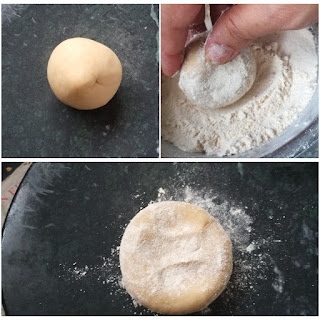Today I bring you the
recipe of the most important part of the meal of every Indian households.
Chapati has become a regular food even in South Indian households. Roti/
Chapati is a staple food in most Indian homes. This whole wheat Indian
traditional flatbread is typically enjoyed as a side with curries or lentils.
Chapati is basically prepared using whole wheat flour, water, salt and ghee/oil
and is served with almost every gravy and curry possible, making the meal
wholesome. Some people did not add salt and oil/ ghee. Even in India, there are
many variations and it is eaten in many countries. Go ahead, check out the easy
steps given below and make these delicious warm and soft chapatis in no time.
These chapatis are no-fuss food and can be packed for lunch or road trips and
picnics. No wonders chapatis are easy-to-make and can be paired with almost
every Indian delicacy. However, the best thing about chapatti/ roti is that it
is high on nutrition and can be twisted as per palate preference. This simple
Indian bread is a far more healthier option than Naan, Puri, Bhature, simply
because you do not need any oil or ghee to prepare this recipe. If you are like
someone who loves the richness of ghee, then you can add some ghee while
kneading the dough and pinch of salt adds a nice aroma and taste to the
chapatis. If not then you can use oil instead of ghee. Roti and Chapati can
used interchangeably. They are cooked on the tawa/ griddle whereas Phulka is
cooked one side on a tawa and the other side on an open flame. Let’s learn how
to make soft roti’s every time.
INGREDIENTS:
2 Cups Whole Wheat Flour
Water as needed
Salt as per taste
1 teaspoon Oil
METHOD:
STEP 1 – Put wheat flour in a parat/ mixing bowl.
STEP 3 – Start adding water in small batches and start
mixing. Add water to get the right consistency.
STEP 4 – Keep kneading the dough well for a while. The dough
should not be too hard or too soft/ sticky.
STEP 5 – Cover the dough with a damp cloth and rest it for
15-20 minutes. It will help to release the gluten and it becomes more pliable.
[see notes]
STEP 6 – Divide the dough in small balls.
STEP 7 – Set an iron tawa on medium high heat. Let it become
hot and then slow down the flame.
STEP 7 – Take one ball, dip it in dry wheat flour. Make the
ball flat and generously dust your rolling platform with flour.
STEP 9 – Then fold it as shown in the picture below.
STEP 10 – Make it round. Dust some flour on the board.
STEP 11 – Start rolling the chapatti with rolling pin. Keep using the flour in order to prevent the chapatti from sticking to the board/ surface.
STEP 12 – Once the chapatti get the perfect round shape, dust off the flour by flipping the roti between both your palms to remove any extra dry flour.
STEP 11 – Start rolling the chapatti with rolling pin. Keep using the flour in order to prevent the chapatti from sticking to the board/ surface.
STEP 12 – Once the chapatti get the perfect round shape, dust off the flour by flipping the roti between both your palms to remove any extra dry flour.
STEP 15 – Flip for more 1-2 times and roast chapatis from
both sides. [see notes] You will see small brown spots and chapatti will start
to puff, indicating that it is completely cooked.
STEP 16 – Repeat the same procedure for all other rotis.
Once done, brush it with some ghee and keep stacking them. Then transfer the
cahapti in a casserole lined with kitchen towel until serving. This way the
rotis will stay soft for more hours.
NOTES: *Apply some ghee/ oil on the dough which helps to keep
the rotis soft for longer.
*Dust off any excess flour before cooking on the tawa.
Otherwise the dry flour can make the roti dry and hard.
*You can use a pair of tongs to flip over the chapatis.
*If the dough gets too sticky, it means more water got added.
Add a tablespoon of flour at a time and knead again till all the flour is
absorbed.
*If the dough is too hard, it means less water was added. Add
a tablespoon of water at a time and knead again. The dough should be soft
enough that if you press your finger against the dough, it leaves an
impression.
















No comments:
Post a Comment